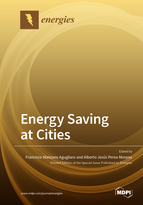Energy Saving at Cities
A special issue of Energies (ISSN 1996-1073). This special issue belongs to the section "G: Energy and Buildings".
Deadline for manuscript submissions: closed (31 May 2020) | Viewed by 30057
Special Issue Editors
Interests: remote sensing; UAV; land cover; land use; sustainability; agriculture; land change; energy; engineering; water
Special Issues, Collections and Topics in MDPI journals
Interests: renewable energy; energy saving; biomass; sustainability; remote sensing
Special Issues, Collections and Topics in MDPI journals
Special Issue Information
Dear Colleagues,
The use of renewable energies and energy saving and efficiency are needs of global society. According to the latest estimates, global energy demand could triple by 2050 and, by then, 70% of the world's population will live in cities. Cities are currently responsible for 80% of greenhouse gas emissions, so they have a key role to play in shifting towards a sustainable energy future. Cities are threatened not only by overcrowding, but also by rising energy demand, obsolete infrastructure, volatile energy markets, and the effects of climate change.
This Special Issue aims to advance the contribution of energy saving and the use of renewable energies in order to achieve more sustainable cities. This Special Issue seeks contributions spanning a broad range of topics related, but not limited to:
Solar energy;
The use of rooftops for energy generation;
Energy conversion from urban biomass or residues;
Energy management for sewage water;
Bioclimatic architecture and green buildings;
Wind energy;
Cogeneration;
Public and private urban energy saving;
Policy for urban energy saving;
Smart meters;
Zero-energy buildings;
Legislations, regulations and standards of energy
Dr. Francisco Manzano-Agugliaro
Dr. Alberto Jesús Perea Moreno
Guest Editors
Manuscript Submission Information
Manuscripts should be submitted online at www.mdpi.com by registering and logging in to this website. Once you are registered, click here to go to the submission form. Manuscripts can be submitted until the deadline. All submissions that pass pre-check are peer-reviewed. Accepted papers will be published continuously in the journal (as soon as accepted) and will be listed together on the special issue website. Research articles, review articles as well as short communications are invited. For planned papers, a title and short abstract (about 100 words) can be sent to the Editorial Office for announcement on this website.
Submitted manuscripts should not have been published previously, nor be under consideration for publication elsewhere (except conference proceedings papers). All manuscripts are thoroughly refereed through a single-blind peer-review process. A guide for authors and other relevant information for submission of manuscripts is available on the Instructions for Authors page. Energies is an international peer-reviewed open access semimonthly journal published by MDPI.
Please visit the Instructions for Authors page before submitting a manuscript. The Article Processing Charge (APC) for publication in this open access journal is 2600 CHF (Swiss Francs). Submitted papers should be well formatted and use good English. Authors may use MDPI's English editing service prior to publication or during author revisions.
Keywords
- energy saving
- renewable energy
- zero-energy buildings
- energy efficiency
- sustainability
- bioclimatic architecture
- sustainable transport
- PV
- CSP
- energy saving in data processing centers







